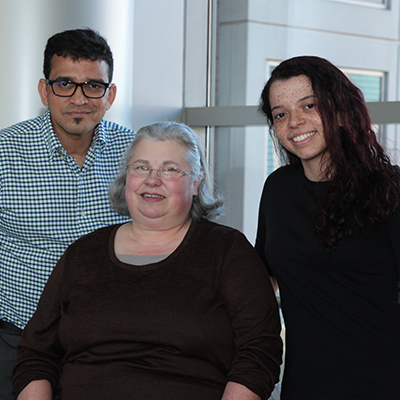CC Grand Rounds lecture focuses on empowered staff, safe patients

CC CEO, international safety expert discuss preventing medical errors, quality medical care
The NIH Clinical Center's CEO and an internationally renowned safety expert discussed enhancing patient safety and delivering high quality care in a Grand Rounds lecture at the Clinical Center on March 22.
Dr. James Gilman, CEO of the NIH Clinical Center, presented a case study on how organizations can react when medical errors happen. This was his first Grand Rounds presentation.
Gilman outlined an incident in 2009 at a previous medical center he oversaw while in the U.S. Army. He emphasized the application of the just culture concept in responding to medical errors that potentially impact large groups of patients.
In this incident, insulin pens were used to treat patients, but instead of discarding the equipment after each use, staff re-used a portion of the insulin pen with new patients. This was contrary to the manufacturer's specifications and meant patients were potentially exposed to epithelial or red blood cells from other patients.
Staff from the medical center contacted over 2,000 patients and set up a call center to respond to patient inquiries and schedule follow up care. Hospital staff also reached out to other hospitals and administrators, all the way up to the Army Surgeon General. This helped identify and change a similar practice at another hospital. The Food and Drug Administration was also notified and issued guidelines clarifying how to use the insulin pens.
In addition to the outreach, hospital leadership had to manage the internal response to this incident. Staff members were re-trained to follow best practices. But the hospital's leaders also had to determine if they would react to this error by punishing the staff involved or focus on learning from the experience and improving.
Either course of action would convey a significant message to the community at the medical center. Ultimately, the hospital leadership focused on training and accountability over punishing those involved in the error.
Gilman applied the lessons learned from this case to a strategic model for the Clinical Center. This guideline helps assess whether errors are due to intentional, unintentional or systemic failures in the hospital and helps with developing the best response.
Dr. Peter Pronovost [disclaimer], the senior vice president for Patient Safety and Quality at Johns Hopkins Medicine and director of the Johns Hopkins Armstrong Institute for Patient Safety and Quality, spoke about strategies to reduce infection rates in hospitals. Pronovost is renowned for developing a checklist protocol to reduce infections associated with central line catheters. His approach has been credited with saving 1,500 lives and $100 million annually and has been implemented across the United States.
Pronovost addressed the topic "Working Toward High Reliability" and opened his remarks by focusing on "improvement science." He suggested that like engineering, it is possible in medicine to set an end goal and build systems to achieve that goal. He emphasized that when basic and applied research collaborate there are often great advances in knowledge.
Pronovost felt many people viewed harm as an inevitable byproduct of medical treatment and saw safety as the responsibility of a "heroic" clinician, unit or department rather than being achieved through systemic design.
However, he insisted harm is preventable. He cited his hospital's goal to reduce catheter infections by implementing and refining improvement plans. Working toward this goal helped his medical team dramatically reduce infections and replicate those results at other hospitals throughout the United States.
Pronovost was emphatic that this design, replicated throughout the nation, was making a difference.
"Catheter infection rates in the United States have dropped 80% [since 1999]," he said.
He emphasized that high-reliability organizations standardize work wherever possible but also need to build resiliency.
This resiliency helps organizations recover from unanticipated challenges.
Pronovost suggested that high-reliability organizations also create a culture with two conditions — respect by all employees for the culture of safety and a desire to learn and improve for every employee from custodian to CEO.
He suggested these strategies lead to empowered employees who approach their work with an attitude of, "I can do something about this."
Pronovost wrapped up with guidelines for organizations looking to integrate zero harm, or any other goal, into all aspects of a hospital's management.
- Determine what purpose you are trying to achieve and assess whether everyone knows this is a common goal.
- Define the core principles.
- Assess what integrated management system you need to achieve your purpose.
- Build governance and management structures that foster trust and learning.
- Ensure shared accountability.
- Create new structures and a culture that aligns with the goal.
Pronovost suggested the best way to assess if an organization was serious about safety was looking at how it measures its progress.
"Safety systems need to be managed with the same rigor as [an organization's] financial systems," he said.
This Grand Rounds lecture is available on NIH videocast.










